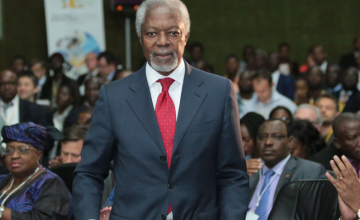Within the context of the New Deal on Energy for Africa, the African Development Bank (AfDB) and South Africa’s power utility (Eskom) on Wednesday, July 7, 2016 in Johannesburg, signed loan facilities for a USD 1.34 billion towards Eskom’s capital expenditure program.
Eskom’s 2016-2020 capital expenditure program includes investments in new generation, plant refurbishment, transmission lines, and capacity building in excess of USD 17 billion. This will help reduce load shedding and increase energy reliability in South Africa and in the southern African region. AfDB estimates this will help boost electricity generation in Africa by nearly 10%, heralding progress toward Bank’s vision to achieve universal access to energy by 2025 under the New Deal for Energy in Africa.
Leveraging its AAA-rating, AfDB has arranged USD 965 million through participation arrangements with nine commercial banks, which include: Bank of China, Bank of Tokyo-Mitsubishi, CaixaBank, Citibank, HSBC, JP Morgan Chase, KfW IPEX Bank, Siemens Bank, and Standard Chartered. The operation represents the largest syndicated A/B Loan arranged to-date in Africa and an important milestone for AfDB’s cross-border mobilization efforts.
By 2020, Eskom’s capital expenditure program is expected to increase South Africa’s electricity generation by nearly 11,000 MW and expand its transmission network by over 9,500 Km. Following the success of South Africa’s Renewable Energy Independent Power Producer (REIPP) Programme, which is expected to increase electricity generation by a further 5,000 MW by 2019, AfDB’s investment will be partly directed at the construction of the transmission network required to evacuate power from South Africa’s IPP programs. The REIPP Programme has attracted USD 14 billion in investment, of which nearly 30% constitutes foreign direct investment, providing a significant boost to GDP growth in South Africa.
“South Africa has the third most attractive renewable energy market across emerging markets (behind China and Brazil) and this program, spearheaded by the South African Department of Energy, is an example of how to approach green growth in Africa,” says Stefan Nalletamby, Acting Vice-President for Private Sector, Infrastructure, and Regional Integration at the AfDB.
South Africa trades approximately 5% of its energy capacity with neighbouring countries in the Southern Africa region. While the country imports electricity from Mozambique, South Africa is a net exporter of energy to Zambia, Lesotho, Swaziland, Zimbabwe, Botswana and Namibia. Moreover, Eskom is considered to be a major “anchor” to upcoming regional energy projects, including Inga III. “By expanding electricity generation, AfDB seeks to support industrialization and job creation,” says AfDB President Akinwumi Adesina, “with the principal objective of improving the quality of life for the people of South Africa and the larger region.”
The signing represents AfDB’s second private-sector operation with Eskom, which builds on its USD 500 million non-sovereign corporate loan approved in 2008. Since 2008, AfDB has also extended three public sector loans to Eskom with funds in excess of USD 1.35 billion, including funding from its Clean Technology Fund. Coupled with its USD 142 million support on Xina Solar One in 2014, a part of the REIPP Programme, these operations help demonstrate AfDB’s continued commitment to developing Africa’s energy sector.


